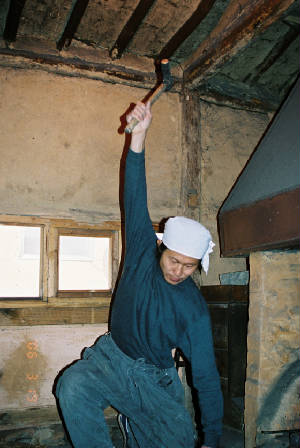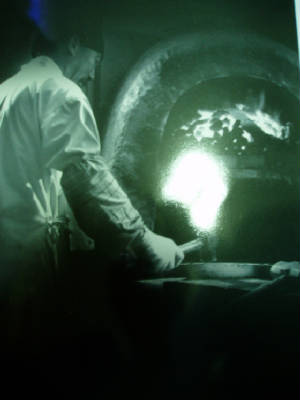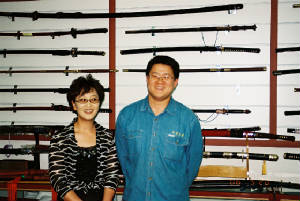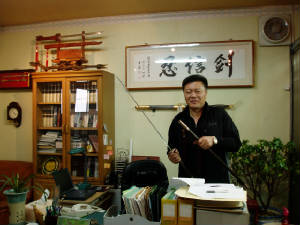|
|
 |
|
Below are just some of Korea's swordsmiths and manufactueres. I will update this section as the
research unfolds.
| Lee Eun Cheol - Rediscovering a lost art |

|
| Traditional hammering technique |
An Interview with Korean
Swordsmith Lee Eun-cheul
Rediscovering the lost arts of ancient Korean swordsmithing
The soul
of a nation can be found in its ancient culture. Preserving the spirit of that
culture is a quintessential characteristic of a mature nation.
About
20 years ago, a young artist named Lee Eun-cheul read an article* about a man named Park Yong-ki who was making “Unchangdo”
knives. Though a ladies weapon, historically this silver knife was lethal. Lee Eun-cheul was inspired by this article.
But, he wanted to go further, he wanted to make swords using the ancient methods.
Thus
began a quest for Lee Eun-cheul which was to occupy the next twenty years of his life.
Specifically
Master Lee set himself upon the task of rediscovering the ancient art and science of Korea swordsmithing. Even more specifically he wanted to reconstruct the old ways of making Paekche and Koryo dynasty swords. Lasting from about 892 A.D. to 1259, the Koryo dynasty ended with Mongolian domination
of the peninsula. According to Master Lee, sword technology in East Asia went from Korean Paekje dynasty to Shilla dynasty
to Japan and then more recently, came back to Korea again. .
Lee Eun-cheul
usually mines his own iron. He digs it nearby his house. It is heavy, black and shiny. He said he needs about 6 kilos
to make two swords.
When
finished, his swords are high carbon steel. It usually takes Lee Eun-cheul somewhere
between three to six months to make one sword. The swords that he makes are not
for sale at any price. Some of his blades have been cut for scientific microscopic
examination. This is useful to scientists who want to know about the metallic
qualities of Korean traditional swords, because he uses the same methodologies in making his swords. Cutting ancient swords for examination would be criminal. Lee
Eun-cheul, however is aware of the needs of scientific curiosity and graciously allows some of his swords to be dissected
for scientific purposes. This is the only place in ROK where this old-style smelting is done. He uses the same smelting methods
as the ancient (Paekje) process 1500 years ago.
Though
what appears to be bloom (ash and slag mix) can be found in his workshop, his blast furnaces are sufficiently hot such that
molten iron pours out. The melting point of pure iron is 1540°C. Repeatedly re-forging
the iron in a carbon rich environment makes a higher quality steel. Lee Eun-cheul then shapes the iron into four sided rods. The rods are cut into short sections about 8 cm. long and layered four or five deep
in a criss-cross fashion. This is done to equalize the carbon distribution throughout
the sword. This roughly cubical shaped structure is heated together in a wooden
push-pull bellows fed charcoal fire and shaped into another rod which when heated cherry red is beaten into rough sword shape,
dipped in ash, heated, folded and beaten again and again. He usually does one
or two quenchings in water. Usually there are three men helping him during the beating process. The strikers say “Hanna, Dul, Set” (1, 2, 3) as they strike, i.e., one striker says “one”
and strikes, then next one says “two,” etc. It is almost like a dance. The master holds and turns the sword to be.
(Modern swordsmiths usually use a “drop hammer” – a compressed air driven forging hammer that drops
vertically onto the work piece.)
When
the rough shape is finished he grinds and then polishes the sword. He generally
uses Australian magnetite powder for the final silver finish. All of his swords are polished, but only a few have hilts and
scabbards added.
Though
Lee Eun-cheul was very specific about many of the techniques he uses in making his swords, he did not elaborate on other details. He did mention that his methodology is sometimes similar to Damascus steel production.
After
many years of research and experimentation with ancient iron and steel manufacturing techniques Lee Eun-cheul went to Japan in 2002 to expand his study of traditional
methods of sword making. In Japan’s Okayama Province, Lee, Eun-cheul studied
the sword making practices of Sword Master Aoki Yutakasan, a famous Japanese swordsmith and member of the All-Japan Swordsmith
Association.
The irony
of this situation was not lost on Lee Eun-cheul, who realized that he had to go to Japan
to rediscover Korea’s forgotten swordsmithing skills, which were
lost near the beginning of the Japanese colonization of Korea.
Located
near Godalsaji temple, his current workshop and home for the past 11 years is located near Yeoju town in Kyonggi
Province, about an hours drive from Seoul.
Before that he lived in Seoul, and before that,
the port city of Busan.
He was born in August 1957.
His work
has been showcased in three documentaries, including MBC program “2580” in 2005:
“History Special Episode.”
Lee Eun-cheul’s
title is Dokumjang (도검장) or traditional sword master. He is Korea’s only traditional sword master at this time. To those who know him, and those who know of him Lee, Eun-Cheul is known as a “Muhyong
Moonhwache” (무형문화재) or “intangible cultural asset.”
Lee Eun-cheul
Mobile Tel: 011-342-3361
*게간미슨 magazine. Vol.
13, 1980 quarterly. Park Yong-ki
and now his son are still making beautiful Unchangdo knives in South
Cholla Province, Kwangyang city.
Story by Gregory C. Brundage & Kim Dammers
_________________________
|
 |
|
| Lee Sang Seon at work |

|
Korean Swordsmith Lee Sang Seon
And the Koryo King’s Sword Institute
Born in Chungnamdo,
in 1953, Lee Sang Seon became interested in swords when he was 18 years old. He
said some of his family members scolded him when he was young for his interest in swords.
“Sword making is superficial and a waste of time,” they said. But,
Lee Sang Seon continued when he realized that he had the skill to make steel, good steel.
Thus, undeterred by criticism, Lee Sang Seon went on to become one of Korea’s finest swordsmiths.
Lee Sang
Seon makes an amazing variety of swords and other weapons from various epochs in Korean history, mostly the Joseon dynasty.
Kings Sword
(Sa-im-kum)
Probably
the most famous of his swords is the Kings Sword called “Sa-in Kum.” “Sa” is a Korean word meaning
“four” and refers to the four essential criteria used in its production.
The Kings sword can only be fashioned in 1) the year of the tiger, 2)
the month of the tiger, 3) on the day of the tiger, 4) at the hour of tiger. Korean
shamanistic beliefs are a big part of the aura, mystery and power of this magnificent weapon.
The last year of the tiger was 1998, the next will be 2010. A special
ancestral rite must be performed when the sword is about 80% finished.
In Korean
history the king did not hand his sword down to his son. Rather, it was buried
with him, thus each king had to have a sword made especially for him. The length
of the sword varied according to the taste of the king, however the length was not supposed to exceed the length of the distance
between the sword held at the hilt while the arm is fully extended down, and the ear.
Historically a large sized Kings sword was about one meter in length. Lee
Sang Seon’s King’s sword blades are 82.84 cm. in length. The total
length is 121.22 cm. The weight is 3.7 kg.
Subjects
Sword (Sam-im-Kum)
These straight
swords are from early Joseon dynasty design. “Sam” means three and
refers to the fact that they can only be made during 1) tiger month, 2) 2) tiger day and 3) tiger hour, unlike the Kings Sword
which also has to be started in the Tiger year. Seventy cm. in length they are
double edged and weigh 2.2 kilos.
Kung Jung
Yu Mul – Palace treasures
These treasures
included an amazing variety of weapons, from swords, to halberds, maces, axes, throwing stars and knives, spears, trident
like weapons and so on. Included in this group is a training sword (“su-ryong-do”)
used in Kumdo (Korean sword fighting) practice. It is this sword that is the
bread and butter of Lee Sang Seon. Many Kumdo Quanjan-nim (Masters) come to him
for these swords. They are replicas of Joseon dynasty swords that are made from
more flexible steel necessary to endure the constant action to which they are subjected.
They are of Joseon design and are curved similar to Japanese samurai swords.
Admiral Lee
Sun Shin’s Sword
One of the
more exotic swords that Lee Sang Seon has made includes replicas of Admiral Lee Sun Shin’s ceremonial sword. It is approximately 1.97 meters in length. He said it takes
about six months to make one and sells for about US$8,000. The buyers have been
wealthy sword collectors.
Lee Sang
Seon gets his raw materials from Pohang Iron Company though surprisingly he gets his coal from Germany. It is a special coal that
he says burns very hot and produces very little ash. He said he uses five materials
in making a sword. He quenches in motor oil.
Because he
works alone, he can only work on a maximum of three swords at a time and it takes about 15 days. Lee Sang Seon sells swords only upon request. He makes swords
for specific customers and no swords are exactly the same.
He received
his license from the Korean government to make swords in 1989. Lee Sang Seon
said that the background investigation required to get a license is exhaustive, they question him regarding his family history
going back three generations, and also his wife and her family history. Then
after passing this rigorous investigation, and paying a rather hefty license fee, the Provincial Chief of Police must approve
the application. On a positive note, Lee Sang Seon said that the standards have
relaxed a little over the years.
Asked about
the differences between Japanese swords and Korean swords, Sword Master Lee said that Japanese swords were made for killing
people, whereas Korean swords were made for saving people. He also mentioned
that Japanese swords typically have a blood groove running along the top side of the blade. He added that Korean swords often
had special lines, pictures or writings painted or etched on the blade usually for shamanistic reasons.
Lee Sang
Seon also mentioned that the Japanese government supports their sword manufacturers, whereas the Korean government has thus
far not supported the indigenous sword industry.
In the year
2000 Lee Sang Seon moved from Incheon city to his current location, in Kyongsangbukdo province, Munkyong city, Uncheokmyon
village. He lives and labors in an old school house complex which he has transformed
into a workshop and museum of Korean
weaponry. As can be seen in the photos, Lee Sang Seon has created an awesome
collection of very authentic looking replica weapons. Kyonki
University in Kyonki province (near Seoul)
has bought a collection of about 40 of his swords which are on display there.
He is a kind
and gracious host to those who visit him and his vast and breath-taking collection of ancient weapons.
Lee Sang
Seon’s phone number are:
054-572-3026
054-572-3025
017-337-1931
Address:
Kyong Sang Bukdo, Munkyong City,
Nong-am-myon, Seon kok li
____________
| Ra Yeun-hee and Kim Hyuk-Ik |

|
| Click on picture to go to "Corea Dokum" site |
An Interview with Ra Yeun-hee
Co-owner of Corea Dokum
Sword Manufacturers
Ra Yeun-hee
is a rather unusual lady. At university she was trained to be a lawyer, a profession
she excelled at. Then, six years ago in a rather unusual move, she went into
the sword manufacturing business. Her husband, working at the Army Collage (Yukkun
Sakuan Hakio) in Daejon city, encouraged and supported her all the way.
Today
she works there with her brother-in-law, Kim Hyun-Ik and a small staff producing beautiful Korean swords. Their shop is located in the small, scenic neighborhood of Shinseongdong, in the suburb of Yusong, on the
outskirts of the very large metropolitan city of Daejon.
The surprises
don’t stop there. For example, she gets her iron from Germany and uses a German sword making machine to produce
swords with Korean design. Her logic is undeniable. German steel and machine technology is certainly respected worldwide.
Even Hyundai hires German engineers to work for them. The results can’t
be denied either. Their swords are strong, sharp and beautiful.
Their mass machine production of swords of ancient design allows them to make swords
cheaper than the competition, and consequently, they do a high volume of sales.
If all
this isn’t amazing enough, Ra Yeun-hee and Kim Hyuk-Ik were very modest about their business. They said they plan to move and upgrade all their systems within the next year or two. (So you better check the address on their internet site before visiting if you’re going there after
2007!)
For foreigners
who would like to buy swords this is a pretty good place, because Kim Hyuk-Ik speaks English rather well, though again, he
was very modest about it and kept denying it!
Like
most people interested in swords, Kim Hyun-Ik had a history story to tell. He
said it’s true that Japanese historically have made great swords, but that Koreans in ancient times usually preferred
bows and arrows to swords, partly because of Korea’s
mountainous terrain.
SOME
SWORDS THEY MAKE
One of
their more unusual swords is called Tsam Po. It actually has a triangular shaped
blade with three cutting edges. This is modeled after an original Korean design,
they said. They also showed us a Hwando Dedo, or Big sword, modeled after a 6th
Century design. Then there is the Chil Song Kum, or seven star sword, originally
made between 1561 and 1597. On the blade are etched, indeed, seven stars. What makes this sword really unique is that two swords fit into one scabbard. They are a perfectly matched pair.
These
fore mentioned swords are collectors’ items.
Asked
about their most popular swords they said two swords in particular have the highest sales volume.
First
is the “Sam-kakdo” a really sharp sword with a rather thin blade. It’s
mainly used by Hedong Kumdo people who practice Poomses (pre-arranged sequences of attack and defense movements) with it. It is also good for the practice of slicing through bundles of tightly bound straw.
Second
is the Yuk-kakdo, a sword with a thicker back used by both Hedong and Taehan Kumdo people for practice for Poomses and slicing
through bamboo trees. It isn’t as sharp as the Sam-kakdo, but holds its
edge well through vigorous use.
Both
of these swords look vaguely like Japanese Samurai swords, but really are Korean designs.
However, when asked by a customer, they do sometimes put a blood groove on the Yuk-kakdo sword because it makes a whistling
sound during Poomse practice.
These
swords can be bought for between 600,000 Won – 800,000 Won, about half the market price of similar swords.
One interesting
difference they mentioned between Korean and Japanese swords is that in the Korean design they use two pins to attach the
pommel to the steel sword handle, whereas they said Japanese swords usually use only one pin.
One of
their more expensive swords looks a bit like the Yuk-kakdo, however is made with special Tanjo (pounded) steel and has gold
inlay on the sword and sheath.
Corea
Dokum retail store is located at 162-10 Shinseongdon, Yusongkoo, Daejon,
South Korea. Their
phone number is 042-863-0076, 0078. The fax is 042-867-7789. email: layounhee@hanmail.net and moon5906@hanmail.net.
Their
internet address is www.coreasword.com
Story
by Greg Brundage
Interview
date: May 20, 2006
|
 |
|
|
|
 |
 |
|
| Kang Cheul Kyu in his office |

|
| Click on picture to go to his site |
An Interview with Korean Swordsmith
Kang Cheul Kyu
Born in July
1956, Yeosu city, South
Jolla province, and the son of a Christian minister, sword master Kang Cheul Kyu is a modern master Swordsmith. Like the swords he makes sword master Kang Cheul Kyu is strong, direct and honest.
He started
to learn about swordsmithing about 25 years ago. At the time the economy in Korea was not so good and he was a young man in search of
a mission and profession. Enter Mr. Yeon. Mr. Yeon is something of a legend in
Korea.
Several of today’s Korean Master Swordsmiths learned their art from Mr. Yeon in Seoul many years ago. Now retired he remains
something a mystery and is held in awe by his former students. Swords master
Kang Cheul Kyu studied under Mr. Yeon for a little more than five years. At the
end of this apprenticeship, he felt he had some creative ideas of his own he needed to develop and consequently moved on to
further his own art. These ideas panned out into the creation of new and superior
swordsmithing methodologies and designs and now are closely guarded secrets.
One difference,
for example between Kang Cheul Kyu and most other swordsmiths is that he uses an electric furnace that he designed himself
rather than the traditional charcoal or coal furnaces. He also uses three different
baths for quenching, using different oils.
Kang Cheul
Kyu also reported that he benefited greatly from advice he received from history Professor Shim Sun Kyu of Korean Physical Education
University, who he said is an exceptionally well informed authority on
Korean swords.
Asked about
the materials he uses to make his swords, Kang Cheul Kyu reported that he uses three different kinds of steel: SK 3, SK 11
and something called Tanjo steel. SK 3, SK 11 are stainless steels used for making
normal quality swords. Tanjo steel, however is very special. “Tanjo” means pounding. It is special very high
quality steel that has been pounded vastly more than the ordinary quality steel. Tanjo
steel swords, according to sword master Kang Cheul Kyu are virtually immortal. He
said that foreigners looking for swords always ask for “stainless steel,” so they buy SK 3. Tanjo steel, however, is unique to Korea and Japan. Another
unique quality of Tanjo is that it “sweats” for several years. Consequently,
this very special hand crafted weapon needs to be wiped down occasionally for a few years after its creation. The SK 3 steel is bought from Japan. The steel that he uses to make Tanjo weapons is from a Korean company.
The following
are only some the swords that Kang Cheul Kyu makes:
Hankuk Do:
“Korean sword”
Chan Kun
Do: “Generals sword”
Sa-in-Kum:
“Kings sword” This is the only double edged blade that he makes. Rather pricy is costs about US$30,000.
Sam-in-Kum:
Subjects sword
Yeong Kum:
Chinese sword – this short straight sword has a very light and flexible
blade. Historically the blade was sometimes concealed in a belt.
Paekje Do:
This sword is rather similar to Japanese style, though typical of Korean swords, there is no blood groove (홈).
Jipangi:
Stick – sword that is concealed in a walking stick made of rosewood.
Hwarangdo
Kum: “Hwarang” was a warrior/scholar class of Korea started
in the mid-sixth century. This exceptionally
beautiful straight sword has a rosewood
handle and scabbard.
Lee Sun Shin
Kum: Lee Sun Shin was Korea’s most
famous admiral renowned for saving
Korea from both Japanese and Mongol invasions. This magnificent and very long sword takes two to three months to make. Historically
it was used for ceremonial purposes. Swordsmith
Kang Cheul Kyu's version of this sword has gold inlay.
Sam Kak Do:
Special Cut Sword – curved sword
Su Ryon Do:
Training Sword – curved sword commonly used by Kumdo practitioners.
Wu-Shu Kum:
Chinese martial art sword – straight blade
Unchangdo:
“Silver handcraft knife”
Most of these
names were created by Kang Cheul Kyu, though basic designs were from historical sources.
Asked about
Park Yong-ki’s Unchangdo (see Interview with Lee Eun Cheol), Kang Cheul Kyu reported that he believed Park Yong-Ki’s
weapon was a “good knife.”
Asked about
getting a license to sell swords, Kang Cheul Kyu reported that the government had liberalized a little and police investigations
into family histories were not a rigorous as in the past, though he said that the license still costs between US$20,000 to
$30,000.
Queried about
government support of Korean swordsmiths, he said that he believed the government doesn’t like swords and only thinks
of them as “dangerous.” Asked if there was an association of swordsmiths
in Korea, he said that there wasn’t.
“Korean swordsmiths are very individualistic,” he added.
Kang Cheul
Kyu has two technicians that assist him in his work. He currently produces about
200 swords a year.
On the subject
of his family sword master Kang Cheul Kyu said that he has one daughter who has had great success working as a model.
Kang Cheul
Kyu has an internet site: dogum.co.kr
His phone
numbers are:
Home: 031-543-5900
Fax: 031-543-0918
Seoul Store: 02-999-8703
Mobile: 011-777-4106
Address:
Kyongki Province, Pocheon City, So-heul-eup Town, Lee Dong Kyo 331-2 It’s
about 30 minutes drive north of Seoul.
Story by
Greg Brundage & Kim Dammers
|
 |
|
|
|
|

Korean swords - An ancient and proud tradition!
|
|
|
 |

